- The Last NORTH ATLANTIC Ocean Liners
- Last Ocean Liners to AFRICA & LATIN AMERICA
- To AUSTRALIA, FAR EAST & AROUND-the-WORLD
- SAILING SCHEDULES January to December 1966
- RANK & COMPARE the Last Ocean Liners
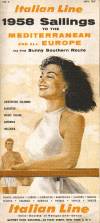 The Italian Line, or Societa di Navigazione Italia enjoyed enormous popularity for their good food and enthusiastic service, and as well for the relatively warm weather of their mid-Atlantic crossings. Italian Line ships all featured several outdoor pools and sunny open deck areas to take advantage.
The Italian Line, or Societa di Navigazione Italia enjoyed enormous popularity for their good food and enthusiastic service, and as well for the relatively warm weather of their mid-Atlantic crossings. Italian Line ships all featured several outdoor pools and sunny open deck areas to take advantage.
Cristoforo Colombo was a beautifully proportioned ocean liner, the finest Italy could produce, even in a land of superb artists. Her unfortunate sister ship Andrea Doria sank in a 1956 collision and was replaced by the new Leonardo da Vinci, an evolved version of the others built for the Italian Line in the 1950s. They had a strong national following.
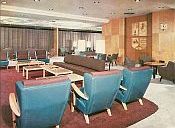 Each class had its own main lounge, dining room and swimming pool with veranda bar. First class and Cabin class each also featured a separate ballroom and First class included an additional cocktail bar and observation lounge.
Each class had its own main lounge, dining room and swimming pool with veranda bar. First class and Cabin class each also featured a separate ballroom and First class included an additional cocktail bar and observation lounge.
The Cristoforo Colombo and Leonardo da Vinci together offered about three sailings per month on the express route from New York to Gibraltar (6 days), Naples (8 days), Cannes and Genoa (9 days).
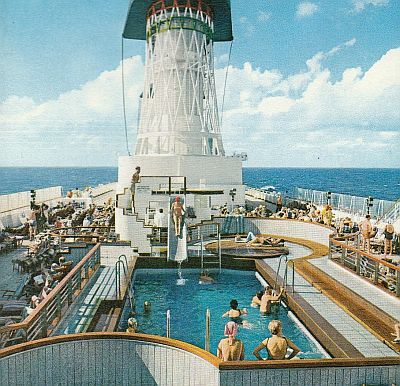 In 1965, the much larger and faster, ultramodern Michelangelo and Raffaello were introduced on the Italian Line's New York express service, cutting a full day off the transatlantic schedule. They were splendid twin luxury superliners with six swimming pools, original artworks, opulent public rooms and private facilities in every cabin. Service aboard Michelangelo and Raffaello was immaculate, food was flawless, wine flowed and the dance bands played on.
In 1965, the much larger and faster, ultramodern Michelangelo and Raffaello were introduced on the Italian Line's New York express service, cutting a full day off the transatlantic schedule. They were splendid twin luxury superliners with six swimming pools, original artworks, opulent public rooms and private facilities in every cabin. Service aboard Michelangelo and Raffaello was immaculate, food was flawless, wine flowed and the dance bands played on.
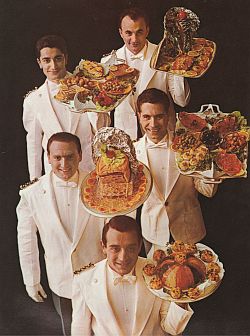 The two former express ships had their black hulls painted white, and were redeployed. Cristoforo Colombo took over the Adriatic route from the retiring Saturnia and Vulcania. Leonardo da Vinci was assigned to a New York to Naples run via Spain and Portugal and undertook more cruises. Soon, Michelangelo and Raffaello began to offer winter cruises from New York to the Caribbean and more ports were added to some of their Mediterranean crossings, rebranding them as "Mediterranean-Go-Rounds".
The two former express ships had their black hulls painted white, and were redeployed. Cristoforo Colombo took over the Adriatic route from the retiring Saturnia and Vulcania. Leonardo da Vinci was assigned to a New York to Naples run via Spain and Portugal and undertook more cruises. Soon, Michelangelo and Raffaello began to offer winter cruises from New York to the Caribbean and more ports were added to some of their Mediterranean crossings, rebranding them as "Mediterranean-Go-Rounds".
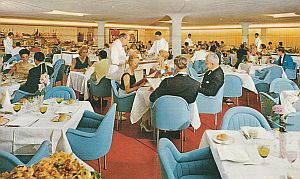 "You are in Italy the moment you step on board and enjoy the beauty of the murals, paintings and tapestries created especially for these vessels by the finest modern Italian artists. Everything aboard is conducive to the complete relaxation of both body and spirit ..."
"You are in Italy the moment you step on board and enjoy the beauty of the murals, paintings and tapestries created especially for these vessels by the finest modern Italian artists. Everything aboard is conducive to the complete relaxation of both body and spirit ..."
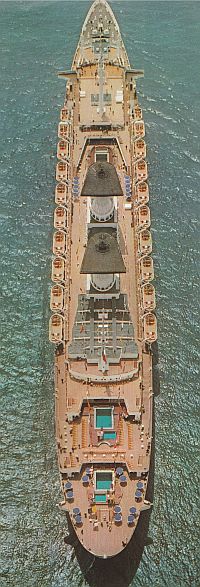 Michelangelo and Raffaello enjoyed some success competing with the new jet airliners for a few years. Nevertheless they were built too late and were largely subsidized by the Italian government. As well, with their strict class divisions and no portholes in the Tourist class cabins, they were considered unsuitable for conversion to full-time cruise ships.
Michelangelo and Raffaello enjoyed some success competing with the new jet airliners for a few years. Nevertheless they were built too late and were largely subsidized by the Italian government. As well, with their strict class divisions and no portholes in the Tourist class cabins, they were considered unsuitable for conversion to full-time cruise ships.
The Italian Line also operated the very fine ocean liners Giulio Cesare and Augustus on the important route from Italy to Brazil and Argentina. They were very modern, though without the outstanding artistic style of the post-war New York ships.  Over a four year period after the 1956 loss of Andrea Doria, Giulio Cesare and Augustus also assisted on the New York run. In 1964, they were converted from three classes to two, carrying the wealthy and notables in First class and tourists and migrants in Tourist.
Over a four year period after the 1956 loss of Andrea Doria, Giulio Cesare and Augustus also assisted on the New York run. In 1964, they were converted from three classes to two, carrying the wealthy and notables in First class and tourists and migrants in Tourist.
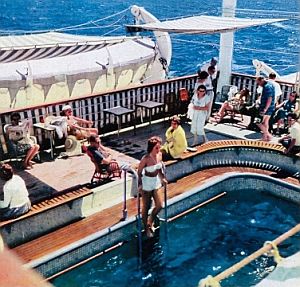 A lesser known Italian Line service connected Italy with the West Coast of South America via Mediterranean and Caribbean ports, through the Panama Canal and then southward to Chile. The last ships employed on this service were Donizetti, Rossini and Verdi, the "Three Musicians", which were obtained from the Lloyd Triestino line in 1963. With up to 14 intermediate ports, there was considerable cargo handling... generally manufactured goods enroute to South America and returning with cotton, minerals and coffee.
A lesser known Italian Line service connected Italy with the West Coast of South America via Mediterranean and Caribbean ports, through the Panama Canal and then southward to Chile. The last ships employed on this service were Donizetti, Rossini and Verdi, the "Three Musicians", which were obtained from the Lloyd Triestino line in 1963. With up to 14 intermediate ports, there was considerable cargo handling... generally manufactured goods enroute to South America and returning with cotton, minerals and coffee.
In 1973, Cristoforo Colombo was transferred to the South America service to replace Giulio Cesare, which had developed serious mechanical issues. In 1977, all Italian Line transatlantic service was discontinued for the usual economic reasons.
Sample minimum one-way fares from New York to Genoa: First class $422; Cabin class $317; Tourist class $253; All fares are per person in U.S. dollars.
Go to Italian Line sailing schedules or select schedules by ship below:
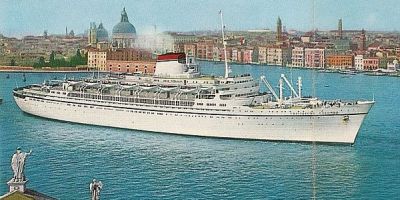 Cristoforo Colombo Built: 1954 by Ansaldo SpA, Sestri Ponente, Italy Go to sailing schedules for this ship. |
 Leonardo da Vinci Built: 1960 by Ansaldo SpA, Sestri Ponente, Italy Go to sailing schedules for this ship. |
 Michelangelo Built: 1965 by Ansaldo SpA, Sestri Ponente, Italy Go to sailing schedules for this ship. |
 Raffaello Built: 1965 by Cantieri Riuniti dell'Adriatico, Trieste, Italy Go to sailing schedules for this ship. |
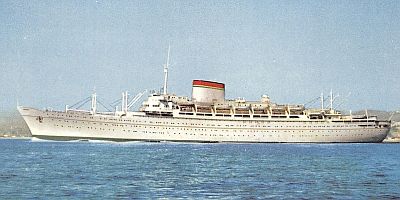 Giulio Cesare Built: 1951 by Cantieri Riuniti dell'Adriatico, Monfalcone, Italy Go to sailing schedules for this ship. |
 Augustus Built: 1952 by Cantieri Riuniti dell'Adriatico, Trieste, Italy Go to sailing schedules for this ship. |
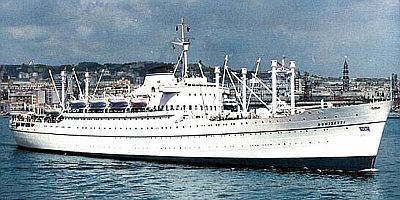 Donizetti Built: 1951 by Cantieri Riuniti dell'Adriatico, Trieste, Italy Go to sailing schedules for this ship. |
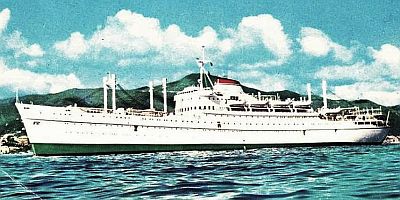 Rossini Built: 1951 by Cantieri Riuniti dell'Adriatico, Trieste, Italy Go to sailing schedules for this ship. |
 Verdi Built: 1951 by Cantieri Riuniti dell'Adriatico, Trieste, Italy Go to sailing schedules for this ship. |